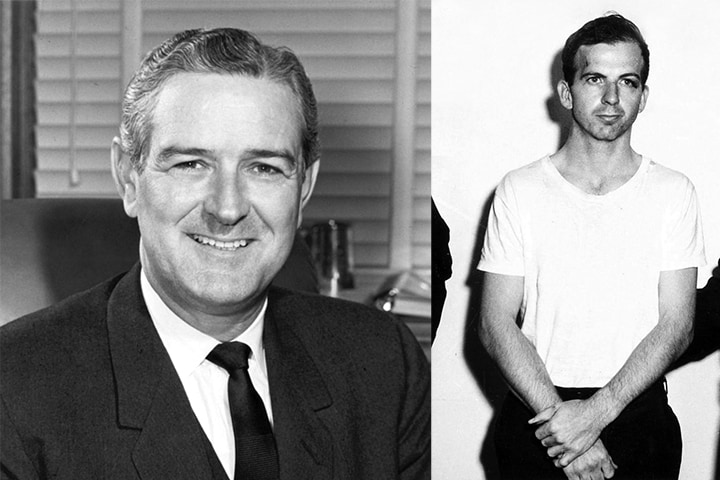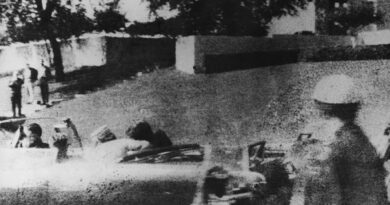Parkland 1963: The ‘Heroic’ Efforts to Save Governor, Assassin

Fifty-seven years ago this month, the president of the United States wasn’t the only famous gunshot patient to be treated at Parkland Memorial Hospital in Dallas. One was a governor who was minutes from bleeding to death and may have ultimately succumbed, 30 years later, to his injuries. Another was an assassin who could have lived – if only a bullet hadn’t nicked two major blood vessels because he twisted away from his assailant.
On the anniversary of Nov. 22, 1963, the lion’s share of attention will surely focus on President John F. Kennedy’s assassination. But the treatment of two other injured men – Texas Gov. John Connally and the infamous shooter, Lee Harvey Oswald – continues to intrigue medical historians.
Connally was in serious jeopardy of dying due to blood loss while Oswald bled out from an unusually devastating injury, said Theodore Pappas, MD, a Duke University professor of surgery, in an interview with MedPage Today. “The Parkland staff performed at a very high level and had great results with Connally,” said Pappas, who interviewed physicians who took part in their treatment for a pair of case reports published in 2015 and 2020. As for Oswald, his treatment was “heroic” but “he had an injury that would be fatal in the best of hands and the best of circumstances,” Pappas said.
Retired Texas vascular surgeon Wayne Delaney, MD, who scrubbed in on Oswald’s surgery as a 30-year-old fourth-year surgical resident, agreed with Pappas in an interview with MedPage Today. “He was injured in one of the most disastrous places to be shot outside of the heart. It was such a lethal injury that not much could be done.”
Kennedy, of course, was shot and killed as he rode in a motorcade on Nov. 22. Gov. Connally, then a Democrat and formerly Navy secretary under Kennedy, was hit as he sat in front of the president in the same limousine.
Investigators, authors, and amateur conspiracy theorists have bitterly debated for years whether the governor’s injuries are evidence of a conspiracy. But little has been written about Connally’s close brush with death.
The Warren Commission determined that a single bullet passed through Kennedy’s neck and then struck Connally. It passed downward through Connally’s body, collapsing a lung and injuring his hand and thigh, writes Pappas in a 2015 case report co-authored with surgeon James “Red” Duke, MD, who was then a fourth-year resident at Parkland. Duke died in 2015 at the age of 86 before the report was published.
Kennedy and Connally both entered the Parkland emergency department at the same time, but the focus was on the president. “Connally was unattended for several minutes, gasping for breath with a collapsed lung, until a resident inadvertently walked into the room and saw what was going on,” wrote Norman Borge, MD, then a medical student, in the 2013 book We Were There, a compilation of memories of the JFK, Oswald and Connally cases.
Duke, who was briefly delayed in responding to a page, arrived to the emergency department to see a woman in a pink suit sitting on a chair — Jackie Kennedy. “There were 30 people trying to save a dead president, and someone says, ‘There’s a guy who’s shot across the hall, you go and see who he is,’” Pappas said. “The only guy in there is a urology intern who doesn’t know what to do. [Duke] walked in and realized it was the governor.”
Connally’s open chest wound was “baseball-sized,” Pappas and Duke wrote, adding that “the bullet had travelled along an extrapleural path through the governor’s chest wall and shattered the fifth rib,” collapsing the right lung.
“He was in severe distress and cyanotic,” wrote William Scroggie, MD, then a medical student, in We Were There. To make matters more complicated, a Secret Service agent with a machine gun came in and told the doctors to scram for a security check, recalled surgeon Jerry Gustafson, MD, in a 2018 interview with the Tulsa World newspaper. The surgeons refused.
The governor improved after Duke inserted chest tubes. The treatment team also hooked up IVs, injected the antibiotic tetracycline, and sent him to the operating room for an open thoracotomy. Surgeons repaired the injuries and replaced the governor’s blood. He’d lost about 1,500 mL.
“It was handled by the book, and that wouldn’t be much different today,” Pappas said.
Surgeons also repaired the governor’s injured right wrist and left thigh. The governor recovered and was discharged after 16 days, although he was readmitted briefly for a wrist wound infection. In a letter dated Nov. 30, 1963, Connally thanked the Parkland staff for the “care, treatment and supreme thoughtfulness my family and I received from you.” The letter ended with a shaky signature; he could not write with his dominant right hand until months later.
Connally was fortunate because he was treated quickly, Pappas believes, and he otherwise would have bled to death within a few minutes. That’s what happened to the civil rights leader Medgar Evers, who suffered a similar gunshot wound earlier in 1963 but couldn’t get treatment as quickly, Pappas said. He is working on a case report about Evers.
Connally would go on to serve as secretary of the treasury under President Richard Nixon, become a Republican, and unsuccessfully run for president in 1980. He died in 1993 at the age of 76 of complications of pulmonary fibrosis. Connally wrote that his doctors attributed the condition to being shot through the lung.
There were two more deaths linked to the Kennedy assassination in the final days of November 1963. Oswald shot and killed a Dallas police officer named J.D. Tippit on Nov. 22 after running out of the Texas School Book Depository. Tippit was taken to Methodist Hospital with a head wound where a medical team tried and failed to save his life.
On Nov. 24, nightclub owner Jack Ruby shot accused assassin Lee Harvey Oswald in the chest – live on national television — as he was being transported through a basement under Dallas police headquarters. “Just as Ruby squeezed the trigger, Oswald flinched to his right in an effort to turn away. The bullet entered his left side, traveling across his body,” writes Pappas in a 2020 case report co-authored with surgeon Ronald C. Jones, MD. He was chief surgery resident at Parkland and treated both Kennedy and Oswald.
An ambulance arrived from a funeral home, as was common at the time, and took Oswald to Parkland. He had a pulse of 130, no blood pressure, and injuries to the aorta, stomach, spleen, diaphragm, inferior vena cava, kidney and liver.
Within 6 or 7 minutes, the team inserted an IV, chest tube, and endotracheal tube and hustled Oswald to the operating room, Jones recalled in an oral history provided to the Sixth Floor Museum. Doctors opened his abdomen, tried to clamp vessels to stop the bleeding – they removed 2-3 liters of blood – and performed a thoracotomy before performing open cardiac massage.
“The surgeons defibrillated the heart and placed a pacemaker into the wall of the right ventricle,” Pappas and Jones wrote. Retired vascular surgeon Delaney, who was present at the surgery as a fourth-year surgical resident, said he wasn’t nervous thanks to his extensive training at Parkland. “I’d done hundreds if not a few thousand procedures. It didn’t even dawn on me to be like a deer in the headlights. Everyone was matter of factly, quickly doing things. There was no panic or anything like that.”
He added that no more than four surgeons worked on Oswald, although the number who say they were there has grown over time: “If everybody who claims they were involved were involved, it would be a pretty crowded situation.”
Oswald was declared dead after nearly 90 minutes of treatment during which he lost more than 8 liters of blood, including 16 units transfused. “There was blood everywhere,” Delaney recalled.
In the oral history, Jones said: “I thought it very likely that he was probably the one who had shot the president, and I think that’s the way we approached him. But by the same token, it didn’t influence what we did.”
Even today, an injury like Oswald’s would kill patients in about 80% of cases, Pappas said. While one modern treatment strategy would be to send up a balloon via the groin to control the aortic injury, he said, the vena cava injury would still be a major challenge.
Oswald’s death didn’t mark the end of Parkland’s role in the Kennedy assassination saga. In 1967, a patient died of a blood clot at the hospital at the age of 55 after suffering from lung cancer. He’d been transported there from prison. The report of his death made the top of the front page of the New York Times. His name? Jack Ruby.
*** This article has been archived for your research. The original version from MedPage Today can be found here ***


